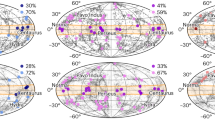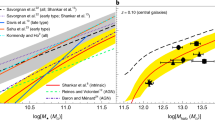Abstract
Detection of anisotropy in the Hubble flow is one of the outstanding problems of observational cosmology. It provides information on the mass density of the Universe and the extent to which the Universe is smooth. This, in turn, permits constraints to be placed on theoretical models of galaxy formation. Our approach to this problem has been to obtain infrared photometry for an all-sky sample of ScI-II galaxies identified by Rubin et al.1 at a mean redshift of 5,100 km s−1. At this distance these galaxies provide information on the Hubble flow well outside the Local Super-cluster. From observations of half the sample, well distributed across the sky, we find a systematic streaming velocity of these galaxies of ∼1,000 ±300 km s−1. In the context of current speculation regarding non-baryonic particle species which may dominate the mass of the Universe, such large velocities on these spatial scales appear to exclude cold dark matter models.
This is a preview of subscription content, access via your institution
Access options
Subscribe to this journal
Receive 51 print issues and online access
$199.00 per year
only $3.90 per issue
Buy this article
- Purchase on Springer Link
- Instant access to full article PDF
Prices may be subject to local taxes which are calculated during checkout
Similar content being viewed by others
References
Rubin, V. C., Ford, W. K. Jr, Thonnard, N., Roberts, M. S. & Graham, J. A. Astr. J. 81, 687–718 (1976).
Tully, R. B., Mould, J. R. & Aaronson, M. Astrophys. J. 257, 527–537 (1982).
Aaronson, M., Huchra, J. & Mould, J. Astrophys. J. 229, 1–13 (1979).
Rubin, V. C., Thonnard, N., Ford, W. K. Jr & Roberts, M. S. Astr. J. 81, 719–737 (1976).
Fall, S. M. & Jones, B. J. T. Nature 262, 457–460 (1976).
Tammann, G., Yahil, A. & Sandage, A. Astrophys. J. 234, 775–784 (1979).
IRAS Point Source Catalog (1984).
Schechter, P. L. Astr. J. 82, 569–576 (1977).
Fixen, D. J., Cheng, E. S. & Wilkinson, D. T. Phys. Rev. Lett. 50, 620–622 (1983).
Lubin, P. M., Epsteain, G. C. & Smoot, G. F. Phys. Rev. Lett. 50, 616–619 (1983).
Clutton-Brock, M. & Peebles, P. J. E. Astr. J. 86, 1115–1119 (1981).
Davies, R. D. & Staveley-Smith, L. Proc. ESO Workshop on the Virgo Cluster (eds Richter, O.-G. & Binggeli, B.) 391–395 (European Southern Observatory, 1985).
Aaronson, M. et al. Astrophys. J. (in the press).
Vaucouleurs, G.de & Peters, W. L. Astrophys. J. 287, 1–16 (1984).
Yahil, A., Walker, D. & Rowan-Robinson, M. Astrophys. J. 301, L1–L5 (1986).
Meiksin, A. & Davis, M. Astr. J. 91, 191–198 (1986).
Blumenthal, G. R., Faber, S. M., Primack, J. R. & Rees, M. J. Nature 311, 517–525 (1984).
Vittorio, N. & Silk, J. Astrophys. J. 293, L1 L5 (1985).
Kaiser, N. Astrophys. J. 273, L17–L20 (1983).
Author information
Authors and Affiliations
Rights and permissions
About this article
Cite this article
Collins, C., Joseph, R. & Robertson, N. Large-scale anisotropy in the Hubble flow. Nature 320, 506–508 (1986). https://doi.org/10.1038/320506a0
Received:
Accepted:
Issue Date:
DOI: https://doi.org/10.1038/320506a0
This article is cited by
-
Large-scale structure in the Universe
Nature (1991)
-
A supercluster of IRAS galaxies behind the Great Attractor
Nature (1990)
-
Large-scale bulk motion and dark matter
Il Nuovo Cimento B Series 11 (1990)
-
A marked concentration of galaxy clusters: is this the origin of large-scale motions?
Nature (1989)
Comments
By submitting a comment you agree to abide by our Terms and Community Guidelines. If you find something abusive or that does not comply with our terms or guidelines please flag it as inappropriate.



